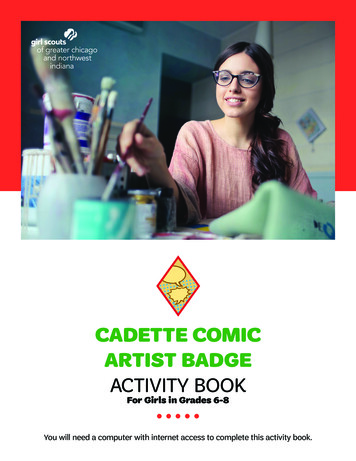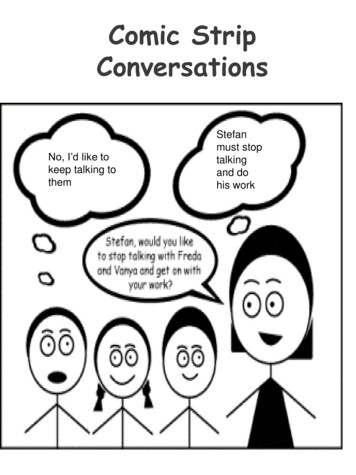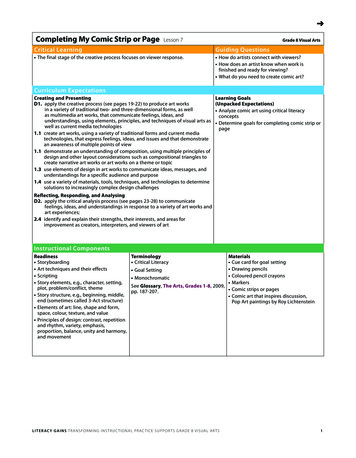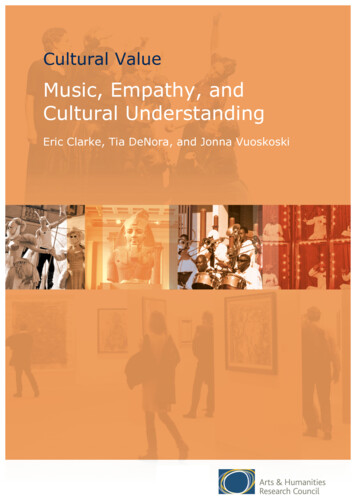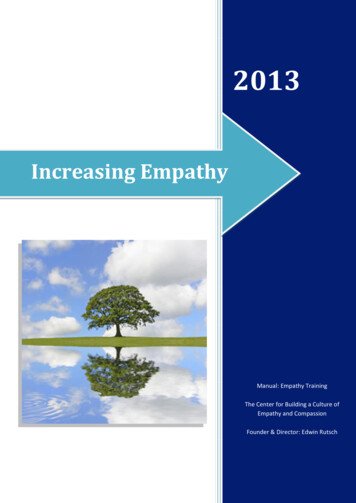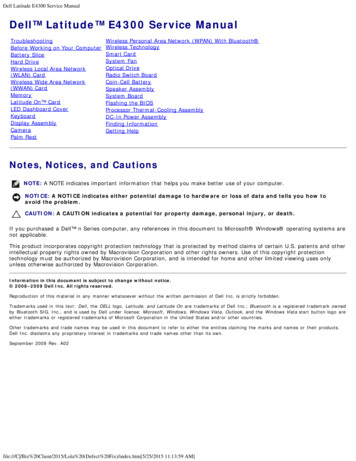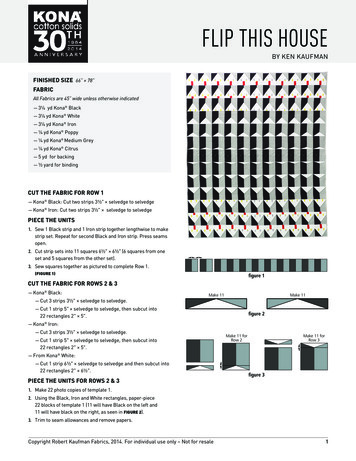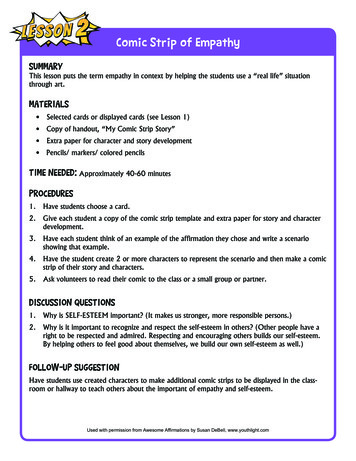
Transcription
Comic Strip of EmpathySUMMARYThis lesson puts the term empathy in context by helping the students use a “real life” situationthrough art.MATERIALS Selected cards or displayed cards (see Lesson 1) Copy of handout, “My Comic Strip Story” Extra paper for character and story development Pencils/ markers/ colored pencilsTIME NEEDED: Approximately 40-60 minutesPROCEDURES1.Have students choose a card.2.Give each student a copy of the comic strip template and extra paper for story and characterdevelopment.3.Have each student think of an example of the affirmation they chose and write a scenarioshowing that example.4.Have the student create 2 or more characters to represent the scenario and then make a comicstrip of their story and characters.5.Ask volunteers to read their comic to the class or a small group or partner.DISCUSSION QUESTIONS1.Why is SELF-ESTEEM important? (It makes us stronger, more responsible persons.)2.Why is it important to recognize and respect the self-esteem in others? (Other people have aright to be respected and admired. Respecting and encouraging others builds our self-esteem.By helping others to feel good about themselves, we build our own self-esteem as well.)FOLLOW-UP SUGGESTIONHave students use created characters to make additional comic strips to be displayed in the classroom or hallway to teach others about the important of empathy and self-esteem.Used with permission from Awesome Affirmations by Susan DeBell, www.youthlight.com
My Comic Strip StoryUsed with permission from Awesome Affirmations by Susan DeBell, www.youthlight.com
I show that Ilove my parentsby doing thingsfor them – evenwhen they don’task me to.I am a goodfriend andsupport myfriends.I am a goodlistener and taketime to hearwhat others aresaying.Used with permission from Awesome Affirmations by Susan DeBell, www.youthlight.comI choose to becheerful andhelp others to becheerful as well.
I appreciatemy ideas andrespect the ideasof others.I am aproblem-solverand helpothers to solvetheir problems.I choose joyand helpothers tobe joyful too.Used with permission from Awesome Affirmations by Susan DeBell, www.youthlight.comI am confidentand encourageothers to beconfident too.
I am thoughtfuland try toinclude othersin gamesand activities.I am my ownbest friendand helpothers to betheir own bestfriend too.I look forthe good inme and thegood in others.Used with permission from Awesome Affirmations by Susan DeBell, www.youthlight.comI am hopefuland encourageothers to behopeful as well.
Activity:Purpose:FEELING TOSSTo provide an active, game-like method to explore feelingsMaterials:Create a poster size tic-tac-toe board. Add pictures of feeling faces (both pleasant andunpleasant) inside the squares of the tic-tac-toe board. You may choose to enlarge the feeling faceson pages 68-69 to use on the poster board. Need two bean bags or coins to toss on the squares. YouthLight, Inc.Procedure: Discuss feelings by tossing the bean bag or coins on the different feeling faces. Asthe bean bag or coin lands on a square, take time to name the feeling and share an example whensomeone might feel that way. This works best if both the student and the counselor give examples.After playing several rounds, you may choose to add to the discussion appropriate strategies fordealing with the unpleasant feelings.Used with permission from Creative Approaches for Counseling Individual Children by Diane Senn, www.youthlight.com
Activity:MUSICAL FEELINGSPurpose:To creatively express feelingsMaterials:Various musical instrumentsProcedure:Display the musical instruments for the child and demonstrate how music canconvey different feelings by playing an instrument with first a happy tune / rhythm, then next asad tune / rhythm, then a scared tune / rhythm. Allow the student to choose an instrument tojoin you. Next take turns with a person playing a feeling and the other person guessing it. Thengive an example of a situation that would have a strong feeling and have the person play whatthat feeling may be. The child can create his/her own situations and play the feeling. Take noteof the situations the child shares and consider if it is pertinent to the presenting problem. Beloware some feeling situations to get you started: How would you feel if someone were teasing you and called you a name? How would you feel if your parents said you could invite someone tospend the night? How would you feel if you had a bad dream? How would you feel if your friend ignored you? How would you feel if a friend complimented you onhow well you played soccer? How would you feel if you made a bad grade on your Math test? How would you feel if you got an A on your Science project? YouthLight, Inc.Used with permission from Creative Approaches for Counseling Individual Children by Diane Senn, www.youthlight.com
Activity:FACE YOUR FEELINGPurpose:To help the child communicate, through their body language (facial cues), what they arefeeling and to be able to “read” others’ body language more effectivelyMaterials:Mirror, pictures of children with different feeling faces copied and cut apart. You mayeven ask a student who has good facial expressions to pose for you to take different feeling pictureswith a camera.Procedure:Show the feeling face pictures discussing what he / she sees in the face that canindicate the feeling. Point out the eyebrows, the gaze of the eyes, any wrinkles on the face, the tiltof the head, and the look of the mouth. Ask the child to make the same face and then look in themirror to check the accuracy of the facial features. Give examples of feeling situations. Take turnsmaking the feeling faces while the other person guesses the feeling. Discuss how knowing andexpressing your feelings as well as guessing how someone else might be feeling can help in getting along with that person. For example, ask, “If a friend was playing with the trucks on the floor,and you came and picked up one of the trucks, and he looked up with an angry face - what might thattell you about what’s going on and what you should do?”MADSAD YouthLight, Inc.SCAREDUsed with permission from Creative Approaches for Counseling Individual Children by Diane Senn, www.youthlight.com
Handout:FEELING FACES YouthLight, Inc.EXCITEDHAPPYPROUDCONFUSEDSHYBOREDUsed with permission from Creative Approaches for Counseling Individual Children by Diane Senn, www.youthlight.com
Activity:FEELING WHEEL*Purpose:To understand the basic feelings of happy, mad, sad, afraid, shy, and proud and to findhelpful strategies for dealing with the feelingMaterials:Copy the Feeling Wheel Sheets (pages 72 and 73), fastening brad, scissors, andcrayonsProcedure: Share the feeling faces on the first wheel. Allow time to discuss, giving examples ofa time the child may have felt that way. Point out that all feelings are okay and normal to have butthat we have to learn to manage our unpleasant feelings in an okay way.Give an example of a helpful and unhelpful way to manage our feelings. Then brainstorm together the strategies to help manage our feelings in helpful ways. Next, show the “what to do” wheeland discuss the strategies shown for appropriate ways to handle unpleasant feelings.Assist the child in assembling their Feeling Wheel – add color to the pictures if time allows.Demonstrate how it works (see directions “For Use” on the Feeling Wheel sheet). Share some ofthe following situations asking the child to turn their arrow pointing to how they might feel in thesituation and then turning the wheel to choose a helpful way to manage the feeling. Allow time toshare and discuss. Feeling situations are: How would you feel if someone teases you?How would you feel if you were the new person in the classroom?How would you feel if you studied hard for a test and made an “A?”How would you feel if your pet ran away?How would you feel if you were pushed out of line?*adapted with permission from Senn (2004). Small Group Counseling for Children Grades K-2. Chapin, SC: YouthLight, Inc.www.youthlightbooks.comUsed with permission from Creative Approaches for Counseling Individual Children by Diane Senn, www.youthlight.com YouthLight, Inc.You may choose to involve the parents by sending the note on the following page.
Handout:FEELING WHEELDirections: Copy and cut out the two circles and the arrow on pages 72-73. Then assemble with thelarger circle on the bottom, the smaller circle next, and the arrow on top. Insert a bradthrough the centers to hold the circles and arrow together.ADMSCAREDSADPROUD YouthLight, Inc.YSHHAPPYUsed with permission from Creative Approaches for Counseling Individual Children by Diane Senn, www.youthlight.com
Handout:FEELING WHEELDirections: When there is a situation, decide what you are feeling and turn the arrow to the feelingface. Next, look at the smaller inner circle and decide which may be a helpful way tohandle the feeling. Then, turn the “What To Do” strategy to the feeling to line up thefeeling, arrow, and strategy.neHATordut oabo thingnkThi some njoy.eyouDOWomeoListen to musicor sing a song.1-2-3.TellsTOTake a deep breath,count to ten,& calm downlembopr y.eht t nt wauoab iffereknThi in a dDrawa or wbou ritetit. YouthLight, Inc.Used with permission from Creative Approaches for Counseling Individual Children by Diane Senn, www.youthlight.com
2. Give each student a copy of the comic strip template and extra paper for story and character development. 3. Have each student think of an example of the affirmation they chose and write a scenario showing that example. 4. Have the student create 2 or more characters to represent the scenario and then m

